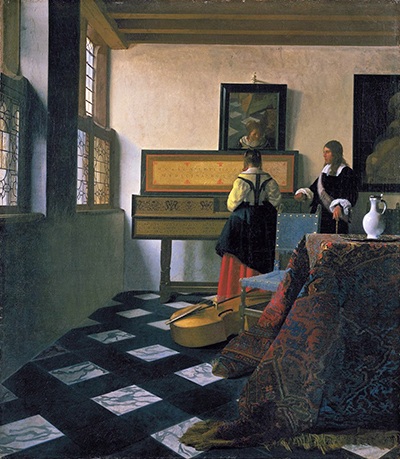Johannes Vermeer produces the artwork The Music Lesson to showcase his exquisite masterful technique through a different approach to his work.
The oil on canvas piece dates back to 1665 as a transitional art piece for the artist.
The painting illustrates a young pupil stowed away at her music lesson with an older male counter part accompanying her. The artwork holds a similar theme to Vermeer's earlier work Girl Interrupted in Her Music.
The artwork showcases a young girl working on her music lesson as she turns away from her instruction and stares at the viewer. Vermeer had continued this theme in his work as he was captivated by the beautiful element of music.
The girl is seated at the bench of her piano as she plays for the male at her right. It is unknown of whether the man is a music instructor, parent or lover.
The man gently analyzes the girls work as he prominently stands at the side of the piano. The girl is dressed in a black and white dress that flows towards the floor of the room as it ends in a blood red colour. He blond hair is pinned up in a bun with a few golden pieces flowing towards the bottom of her neck.
The beautiful element to note within the artwork is the meticulous attention to detail showcased by the artist on the piano. The piano is painted in a light golden colour with an extravagant red and green mosaic design covering the artwork. The perimeter of the piece is covered in green linear lines to accentuate the piano.
The masterful oriental design depicted on the piano holds a similar style to artist Gustav Klimt as he enters his gold phase in a couple centuries after Vermeer such as in The Kiss and Schubert at the Piano. This beautiful style continues to captivate audience worldwide as the sharp gold colour adds a sense of luxury to the work.
The artist is most prominently known for basing his artwork on a linear flattened viewpoint, however within the painting Vermeer enters a 3D approach. The artwork used the bottom left centre on the floor as a focal point to properly structure the artwork.
This method elongates the artwork creating a grander perspective than what the viewer is familiar with in the artist's work. El Greco would use a similar method of elongation in his portrait work, as would Edvard Munch in The Scream.
Vermeer continues to showcase the exquisite luxury of the characters by adding details throughout the piece that illuminate their wealth. The floor is covered in a black and white marble print that covers the room. The luxurious piano was an incredible wealth to be able to afford at the time. The silver jug located on the table is a common accessory located throughout Vermeer's work as in A Girl Asleep and The Glass of Wine.
Vermeer continued his classic style of including a light source within his work by placing a grand window at the left side of the work. The mosaic pattern covers the wall of the window as light seeps into the room illuminating the objects. The artist had interestingly included a mirror above the girl playing the piano adding a sense of depth in the work.
However it is fascinating to witness that the view in the mirror does not properly reflect the girl playing the piano as her head is painted straight but the reflection is altered. It is unknown if the act was a mistake in the artist's work or if perhaps was done on purpose as a message that the artwork is only fiction.




